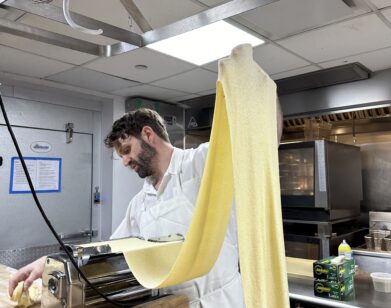Visionaire
For Visionaire, the cultish, shape-shifting New York magazine whose output routinely becomes an instant collector’s item, each new issue has been an opportunity to venture where no publication has previously ventured. Thus, the prospect of condensing its 25-year history into a single anniversary monograph veered into existential territory. “We never think about what we do or analyze it,” says Cecilia Dean, who, along with James Kaliardos and Stephen Gan, founded Visionaire in Kaliardos and Gan’s downtown apartment in 1991. “So then to ask ourselves, ‘What is it and what’s important about it?’ was a huge exploration.” The result is the book Visionaire: Experiences in Art and Fashion (Rizzoli), a rich fashion-meets-art compendium featuring highlights from all 65 issues. Kaliardos says the process was more cathartic than celebratory: “It allowed us to let it all go,” he says. “I feel strongly that we don’t need to cling to our past to define us; we’re defining ourselves by what we’re creating now.”
While Visionaire has always felt like a flip through the future—a very high-end, brightly lit, couture-uniformed future—the magazine does have a storied past. Inspired by the creative energy of the early-’90s club scene, Dean, Kaliardos, and Gan (who has since left the publication) imagined a platform for of-the-moment artists to be given nearly full creative control. Themed issues have taken the shape of everything from a deck of cards to a series of nesting dolls, and featured work from a range of cultural luminaries: Maurizio Cattelan, Jeff Koons, Kara Walker, Yoko Ono, and David Bowie, to name but a few. With all this in mind, Dean and Kaliardos deliberated about what form the Rizzoli book should take. Should it include a scratch-and-sniff component or lenticular pages? Should it even look like a book? (“One idea we had, you wouldn’t even be able to hold it,” Kaliardos mysteriously suggests.) Eventually they settled on a traditional coffee-table format, without any snazzy accoutrements. That practical decision might just be another indication of how Visionaire is always one step ahead of the pack. “We wanted it to be reasonably priced,” Dean says of the book. “I think whenever you publish something, you have to ask yourself: Is it worth chopping down the trees? Are people going to keep this and cherish it and show it to other people? Or is it disposable? We have always been very anti-disposable.” Dean is correct: There has never been a single sighting of a Visionaire in a recycle bin.







